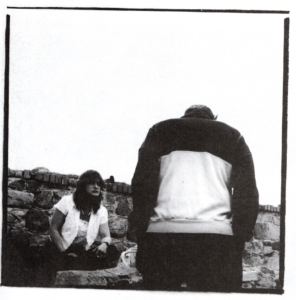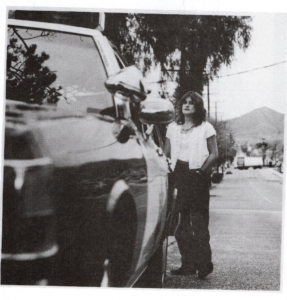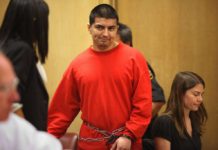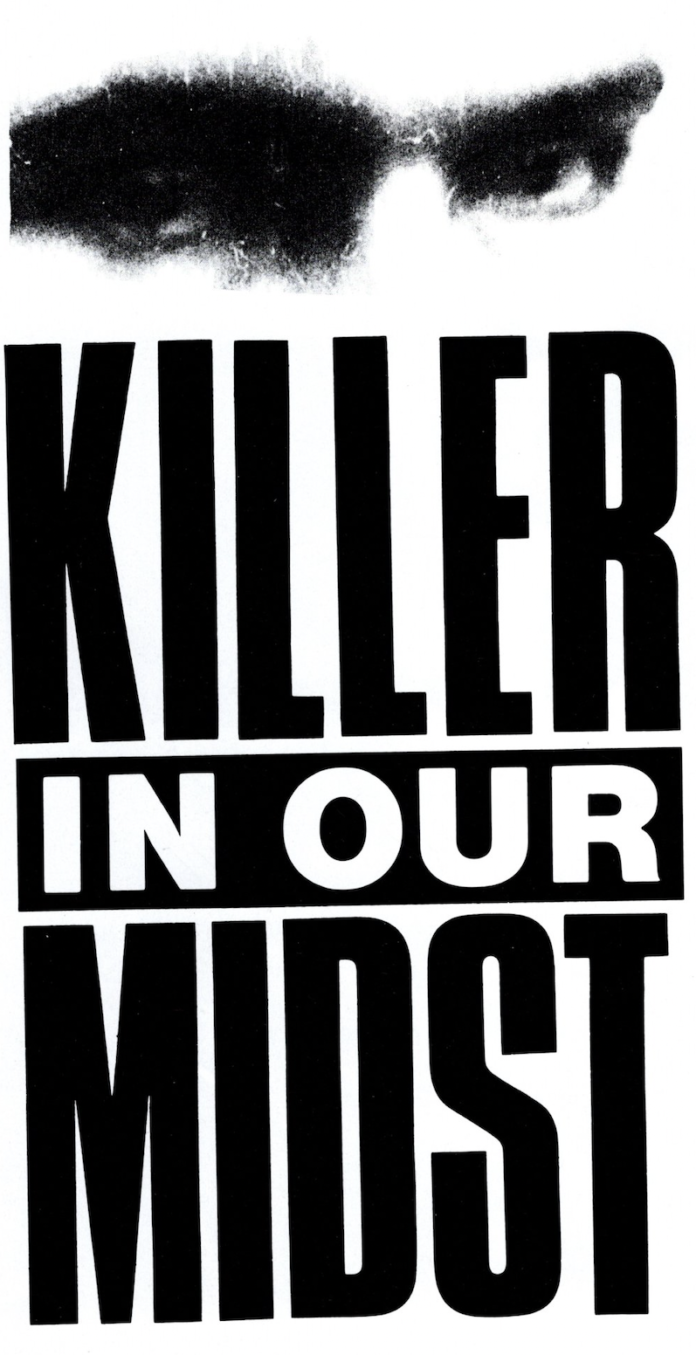
There’s a serial killer loose in Riverside County. So far it’s been mostly hookers.
By Mark Cromer
[This article was first published in 1991 by Inland Empire Magazine as a serial killer’s feeding frenzy targeting prostitutes in Riverside County, California, was into what was then thought to be at least its third year. The killer often posed his victim’s bodies on roadways around Lake Elsinore, a former resort town that, somewhat like the killer’s victims, had fallen on hard times. In January 1992, Riverside County employee William Suff, then in his early 40s and known for his chili recipes and affinity for ride-sharing programs, was arrested after Riverside police stopped his van after observing him cruising an area known for prostitution and discovered a variety of items inside it that linked him to the killings—the most recent of which had occurred days earlier. In July 1995 a jury convicted Suff of murdering a dozen women and, during his sentencing phase, prosecutors informed jurors that Suff had been convicted in Texas for the 1974 killing his two-month-old daughter; he had been sentenced to 70-years in that case, but was paroled after a decade behind bars. In California, Suff was sentenced to death. While convicted of murdering 12 women between 1988 and 1991, investigators believe Suff may have killed as many as twice that number of women dating back to the mid-1980s. The California Supreme Court has rejected his appeals. Now in his 70s, Suff remains on Death Row today, where despite overwhelming support by California voters for the death penalty, Governor Gavin Newsom has proudly declared that no convicted killer will be executed on his watch. In a 1996 reader’s poll for its 20th anniversary issue, Inland Empire Magazine named the article its Best News Story.]
The knock came late.
It was sometime close to midnight when Julie heard the light tapping on her bedroom window. She had been waiting and was ready when it came. Already dressed, she hopped out of her bed and headed for the front door of her parents’ Lake Elsinore home, being careful not to wake the rest of the family. But Julie’s teenage niece, who shared a room with her aunt, had also heard the knock, and watched silently as Julie walked outside to meet a tall, thin man with long blond hair. Julie knew the guy—the niece had seen him before. The two got into his truck and left. A short while later Julie was spotted at a local bar in a nearby section of town known as “Four Corners.” Fights are common there, and it is said there was a big one there that night. Julie left as the bar was closing, sometime after one in the morning, fading away into the darkness.
Approximately four hours later, a group of migrant workers found the nude and severely beaten body of Julie Lynn Angel on a small turn-out of a service road that runs alongside Interstate 15, just over four miles from her parents’ home. Her face was so badly mauled that authorities identified her by a rose tattoo on her right shoulder blade. Her parents were not allowed to see the body.
Julie, a 36-year-old mother and prostitute with a history of heavy drug use, had become victim number five in the bloody spree of a serial killer who, like Jack the Ripper before him, has developed a taste for hookers.
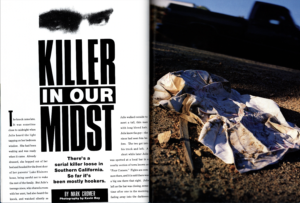
Since her death in November of 1989, the bodies of eight more women have been found in the Lake Elsinore area, and five the Riverside area. All were beaten, stabbed or strangled to death, and it is believed all had a background in prostitution and drug use. Most of the women were local prostitutes, white, and between their mid-20s and early-30s.
Almost all their bodies were dumped close to stretches of Interstate 15.
The killings have not only stumped investigators (at least thus far) and tortured the families of the victims, but they have embroiled the small rural town of Lake Elsinore in a debate that centers as much upon the lives of the victims as it does the motive of the killer.
On one side are the families of the victims and their friends, who talk openly about the murders as much as possible. On the other side, they say, are the local business leaders who have been accused of trying to hush up the murders in an effort to protect their cash flow.
Like the mayor of Amity in Jaws who ignores the fact that a shark is cruising the shallows and chomping swimmers left and right, business leaders in Lake Elsinore, it’s said, are simply looking the other way as the bodies of one “working girl” after another are dumped along the roadside.
This “it’s-only-a-bunch-of-whores” attitude surfaced recently when an unidentified real estate agent in Lake Elsinore told a reporter from the Los Angeles Times: “It’s not like we have a Hillside Strangler here. We have a health nut. He’s just cleaning up the town a little.”
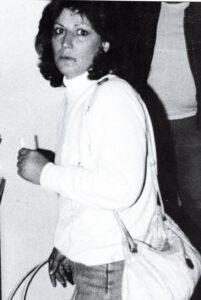
That sort of talk embitters the other side and leaves investigators wincing, trying to deflect the image that the locals, by and large, just don’t give a damn that somebody has decided to make a habit of killing the town’s prostitutes. But to some in Elsinore, that attitude is undeniably clear.
Patricia Lovitt runs Granny’s Kitchen, a local diner that is a favorite of sorts among the townies. It’s a small joint nestled strategically off Main Street, right next to a bar called The Wreck. When she’s not working for the paying customers that come through the front door, Lovitt said she’s handing out food and odd jobs to the hookers and homeless through the back door of her kitchen. She hears the news from both sides.
On a late afternoon as the diner is closing, Lovitt takes a few moments from her kitchen duties and sits down for a cigarette and some talk about the killings and the town. There are a few locals still nursing their last cups of coffee and Lovitt speaks in carefully measured tones, keeping her voice down.
“You know, I took a lot of heat and criticism for speaking out the last time. The businesses downtown said ‘What are you trying to do? Kill business?’ But we wanted to stir up the pot a little bit. It didn’t seem like the police were doing much.”
Today, however, she makes it clear that no such doubts remain about the intensity of the sheriff’s department investigation.
“Well, I think they are doing the best they can. I don’t feel they’re sitting on it. Christ, one day they dug up a hill.”
Yet as the investigators continue to dig, Lovitt said that little has changed in downtown Elsinore, from the hookers still walking their beats along Main Street to the business owners downtown who detest them so much they equate their killer with someone who eats granola bars.
As she takes a good long drag on her cigarette, Lovitt looks out the window toward some of the small shops along Main Street. She knows the real estate agent who made the comment to the Times and, for the most part, she said, he was speaking for the town.
“They’ll deny it if you bring it up, but the [comment] typifies the town’s attitude.”
Another small business owner in town agreed.
“You want the truth? [The attitude is] ‘Another one bit the dust.” They don’t give a damn. There isn’t any ‘We’re scared!’ or ‘We’ll lock the doors!’ There just isn’t any of that,” adding that the prostitute victims of the killer are generally seen as less than human.
“They don’t realize these people have families, they have children.”
The mood downtown has grown ugly enough that those who speak out, the business owner said, are quietly boycotted in return.
“What’s the bottom line? Money. If you’re in real estate and murder and dope keeps popping up, how can you sell that beautiful house? How can you sell that property?
“People are afraid of financially getting hurt. The bottom line is money.”
But not for Robert Chapman. No, the bottom line for the father of Julie Lynn Angel is something quite different from keeping a “positive” image, increasing business or maintaining a cash flow.
The bottom life for him is the truth, and a few things that he expects will come with it. Like a killer brought to justice. A suspect, a trial, and a conviction.
And he has though of little else for the past year.
As he leans back in a big leather chair, one of four that ring the television set that sits in the living room of his comfortable home, he seems to put the two teenage girls running around the house out of his mind.
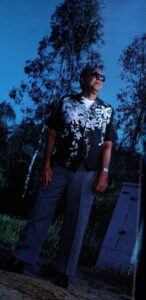
One of the girls is Julie’s daughter, who he is now raising. The other is the niece who was the last one to see Julie alive.
Chapman concentrates on the murder that has held his attention for so long now, and then sums up his drive to help solve it.
“The only thing I am trying to do is to make the citizens of these nearby communities and Lake Elsinore [aware] that we have a killer in our midst. And the important thing I am trying to do is to maybe jog a memory—of a car backfiring, a truck parked along a desolate road, a vehicle that is out of the order or seems insignificant at the time—any little thing is important.”
Indeed, along with investigators, Chapman, who has spent 16 years in the private security field, is grasping at whatever straws he can that might lead to a suspect. He works closely with investigators on the case, even clearing his interviews with them, and through at times it gets fairly dismal, Chapman said that he’ll pursue it until the killer is caught, or he himself moves on to his grave.
Whichever comes first.
“I am not a crusader, but I want to know what happened to my daughter and who killed her. And I will devote the rest of my life until I find out who did.”
Perhaps he is not a crusader, but as he speaks about his daughter, her life and the brutal end she came to, it is clear that he is a man possessed with a thousand questions. Questions that may never be fully answered.
He said the identity of the tall blond guy his daughter was last seen with is still unknown.
Though he knows that his daughter was beaten to death, he still seems gripped by the fact that it is still uncertain where or how exactly she was killed.
Julie’s official cause of death was blunt force trauma to the head, but caused by what? Chapman thinks a hammer. He figures a ballpeen hammer. The kind a carpenter might use.
And it is surreal, almost morbid, to listen to a father candidly discuss what instrument a maniac may have used to eliminate the left side of his daughter’s face. But he talks about it anyway, mulling over his words carefully, as if they might hold some overlooked clue, some single little thing.
And it was the left side of her face, Chapman notes, which means the suspect is probably right-handed, which narrows it down only a little. Still, that’s just one more thing to consider by Chapman’s calculations.
“This man is not sex-crazed at all; he’s very shrewd. Very shrewd. I think this man has some knowledge in criminal justice, to know that he has to do certain things to protect himself.”
As the town remains silent and the families of victims wait, investigators are scrambling to pick up the scent of the killer, before more victims begin turning up. The body count now numbers 14, and if this serial killer is anything like his infamous peers, he will not stop until caught.
Sergeant Danny Miller heads Riverside County Sheriff’s three-man investigative team for the Lake Elsinore killings. The team, which is now only a few months old, works out of a cramped portable that sits in the parking lot of the sheriff’s station. The walls of this tiny command post are lined with photos, maps, charts, sketches and various other paraphernalia associated with their search.
Though they have received top marks from both the families of victims and business owners, how much progress Miller and his team are really making is known only to them, and perhaps the killer.
Of the many questions that surround the death of Angel, several seem to stand out. Yet, while the investigation is active, Miller and his team are reluctant to part with much information.
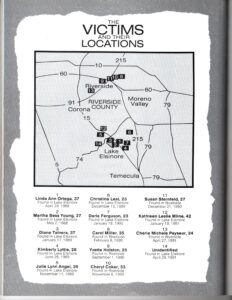
A bloody shirt was listed in a report as evidence recovered at the scene where her body was found, but Miller said he couldn’t recall if a shirt was found there or not. Shell casings found at the scene were also noted in the report, but Miller said they weren’t related to the crime.
The report states, “Physical evidence in the area… suggests that the subject was killed in this area.”
Miller doesn’t agree.
“I doubt very seriously she was killed there.”
Why the contradictions? One reason might be that investigators are holding information that is known as “guilty knowledge.” Essentially the term describes an aspect of the crimes that only a suspect and investigators would know about. Investigators working the Hillside Strangler case knew that the suspects were using a police badge when dealing with their victims, but this fact was kept from the press.
With such information under wraps, the police can effectively use it as a polygraph “key.” This is done during a polygraph test with a suspect, where the investigators will ask a series of standard questions and then throw in some thing that only the killer would know, watching to see if it sparks a reaction.
Though polygraph test results are not admissible as evidence in court, they help investigators screen out fakes as well as help them with suspects they are uncertain about.
As one investigator noted, one of the first things a defense attorney will do is wade through the press clippings generated by the case. Once in court, defense attorneys could harpoon any such “guilty knowledge” by pointing out “anyone who reads the papers would know this.”
Such tactics can hinder prosecution, the investigator said, if critical evidence winds up in the media before an arrest.
Though the arrest and charging of a suspect is something that has alluded them thus far, Miller said he is confident the extra manpower on the case, which until the formation of the team was handled by individual detectives, will help get things rolling again.
A psychological profile on the suspect has been done for the team by the California State Department of Justice, and though Miller declined to comment specifically on the profile, he did say the real estate agent’s assertion the killer was just doing a little street cleaning might not be too far away from the mentality of the killer.
“That’s just somebody’s conjecture, but that is one possibility. When you look at the psychological profile, that’s one thing that would be considered.”
Michael Bach, an LAPD veteran and professor who teaches criminal science courses at Golden West College, had several students who constructed a profile on the killer in Lake Elsinore.
Though he noted the profiles were based mostly on general information available through the media, he said that the killer would more than likely resemble much of what the students constructed.
If Bach and his students are correct, investigators are looking for a killer who is a white male, between the ages of 20 and 25, with a middle-class background. Chances are it will be someone who knows the area well, perhaps a local who is in construction work.
One of Bach’s students surmised the killer has an extreme Oedipal complex and with each murder is venting hostility, striking back at Mom who may have been abusive and fit the general description of his victims.
While the exact madness that motivates this killer is still uncertain, Bach said most serial killers in the United States have similar backgrounds.
They are mostly white males that come from middle-class, two-parent families. They tend to be either the oldest child or the only child. At the age of 11 or 12, the father in these families tends to become peripheral, Bach said, throwing the child into confusion. Though generally quite bright, problems start at school. Problems also may develop with the opposite sex. By the time they are in late adolescence they are being raised predominantly by their mother.
And they are loners, rarely having friends closer than acquaintances.
Bach stresses this, as he said it is a key reason why serial killers can wantonly slaughter without showing signs of guilt or remorse, unless it’s in a manipulating manner.
“Our remorse, our guilt, is based on our bonding. Serial killers don’t bond. They are sane under the law, but they don’t bond. They look at people as objects. A sociopath can be sane, but they don’t feel other people’s pain. They are extremely narcistic and egotistic and they don’t get outside the realm of their own pleasure and pain.”
When serial killers turn up to have wives and children, Bach said it is because they are blending in with what society expects of them on the surface.
“They’re on autopilot, they’re just going through the motions.”
And how many killers are just “going through the motions” today in the United States? The numbers are almost as frightening as the killings themselves. Bach said of the 25,000 murders in this country every year, he believes 5% are the result of a serial killer. He admits, however, his is a conservative number. One noted specialist believes 25% of the homicides in the country are committed at the hands of serial killers.
And Bach is quick to note that it is primarily in this county that serial killers enjoy their bloody reign.
“It seems to be a phenomena indigenous to the United States. There just aren’t hordes of serial killers in Japan or Europe.”
While serial killers come from all parts of the country, Bach said that a substantial number hail from the southern region of the nation. As to why America produces such a vast harvest of bloodthirsty men, Bach said one reason is how violence is looked upon by the country.
“We are programmed today to enjoy violence. Violence is rewarded in this country, we are predisposed to violence. Look at the prevalence of guns in our society.”
A gun is something that hasn’t been used in the Lake Elsinore slayings, a fact that Bach said indicates the killer there is particularly sadistic.
Yet while he has brutally killed them, there doesn’t appear to be evidence that they were sexually molested before or after their death. Miller said that it is hard to say whether the women were raped before they were killed because of the line of work they were in, though sexual torture, often a trademark in serial killings, doesn’t appear to be evident.
Despite the questions that surround the case and continue to plague investigators, Bach said that one thing is almost certain. The killer will not stop, no matter how close he comes to capture.
“No, he won’t stop. This is an appetite. Just like you get hungry and have to eat, he gets hungry and he has to kill.”
And Bach said that when and if the killer travels, so will his appetite.
As Mary Bucher takes a break on the back porch of her massive home in Menifee, she scans the valley below. It’s a clear April day, white billowed clouds hang high in the air and the distant sound of cars passing on the road below is the only racket to be heard. That and the sound of her seven-year-old granddaughter, Jennifer, playing in the garage with her rabbit.
Jennifer’s mother, Darla Ferguson, was the seventh victim of the killer, murdered just over two months after Julie was killed. Bucher speaks softly but without hesitation as she remembers how her daughter-in-law’s body was discovered.
A mother and her son were out driving on a dirt road, looking for fire wood, when the little boy spotted what he thought was a pair of legs sticking out of the underbrush. His mother didn’t believe him, but backed the car up just to prove he was wrong. He wasn’t.
Darla, Bucher’s son’s ex-wife, had been strangled and dumped less than a mile from where another victim, Kimberly Lyttle, who was also strangled, had been found. Darla reportedly had a plastic bag over her head when she was found.
Jennifer was staying with Bucher at the time her mother’s body was found, but it wasn’t until the next day that detectives knocked on her door.
“I had read the paper where they found a body that appeared to be in her 30s, but Darla was only 23, so I didn’t think it could be her. When the detectives came in I saw the newspaper and said, ‘Tell me that’s not why you’re here.’ They said, ‘We’re sorry, but it is.’”
Looking at the mug shot the papers have continually run of Darla, it’s not hard to see why she was initially thought to be much older than 23. What Bucher described as a once beautiful blonde girl had evaporated into a hard-looking woman with sullen eyes, greasy hair and swollen lips.
“The papers keep using the mug shot [provided by a police department] but she was a beautiful girl, just beautiful. Then she got on drugs and she just went down to a skeleton.”
That look Darla sunk into—the distant glaze in her eyes that told one she had “been there”—is seen over and over again in the 10 other faces that also fell victim to the killer [one victim remains unidentified].
As she talks about it now, over a year later, Bucher still has a hard time believing the level of hate and violence that must permeate the killer’s soul. Yet as brutal as the crime was that took Darla’s life, Bucher said it was a life filled with agony from the start.
“Her life was a nightmare. I’d see Darla quite often and when things would get bad I’d get her to leave Jennifer here. She would live in her car with no food or money. At the end she was into heroin. …at the end she was into everything.”
Bucher remembers the last time Darla came to see Jennifer before she was killed. It was Christmas Eve 1989 and she stopped by to help Jennifer frost some holiday cookies. She was also stoned out of her head, Bucher remembers, and she left the house after a short while. They never saw her alive again.
Bucher said that friends had seen Darla at a boyfriend’s house on the morning of January 17 and that she was reportedly seen in nearby Perris a short time later.
“Perris is where the heroin is,” Bucher notes.
Bucher contacted Chapman after she saw him in a newspaper article and the two have stayed in touch over the past months, as more bodies are found. Like Chapman, she feels bitter about statements like that of the real estate agent, believing that if the killer is on a holy war to clean the streets of the community, such statements will only encourage him.
“Some people feel the way that agent does, but then I’m sure others are a bit more intelligent…. He just gave someone [reason] to go kill again.”
As the days wind away, Bucher and her husband continue to debate whether or not they should sell their comfortable spread on the hillside and move away. Ironically, Bucher knows that it is impossible to run from your troubles. Her family moved to Menifee from Fountain Valley 14 years ago to escape crime.
Jennifer, who spent a year in therapy after her mother was slain, knows at this point only that “Mommy is in heaven.” Yet no matter how far away they move, the questions will eventually still have to be dealt with.
“She didn’t talk about her mother for about a year. She’s just now starting to ask about her. She’s getting curious, asking questions.”
Answering those questions will involve a pain that the killer can’t comprehend, Bucher said, nor apparently, a thoughtless businessman.
“What is so sad is that though nothing is going to hurt these girls anymore, they had children… the pain will linger.”
As for the killer, Bucher is confident that it will be only a matter of time before he gets caught. The question, she said, is how much more time and how many more bodies?
“Eventually he’ll be caught, but I don’t think he’ll stop until he’s caught. It’s just like Bundy. How many did he do before he was caught?”
OUTTAKES
Here are a couple more photographs taken by Kevin Roy; one of the best photographers I ever had the opportunity to work with back in the early days as we hung out on the streets of Lake Elsinore in 1991 reporting what would become the story Killer In Our Midst. These two shots never made Inland Empire Magazine, but I published them several years later in Low Magazine as part of a curation of his work.
